Wiring Specifics(here we go...)
What you need: Here I will concentrate on wiring OBD II computers that have distributors. This includes 97-99 TJ’s and 96-98 Grand Cherokees. You will need a PCM that does not have a security system. Most likely, you wont have the PDC so I will teach you how to wire relays individually. Because they changed the wire colors every year, I cannot give you wire color specifics. For the most part, the correct wires run through the same connectors and are in the same location on those connectors with a few exceptions. To do this correctly and accurately, you’ll want the electrical manual for the donor engine year available at the dealership. The most important diagrams, which are the pin out diagrams for the PCM, are available here:
97 TJ pin out diagram(excel)
98 ZJ pin out diagram(excel)
To complete this swap in any kind of timely manner, you’ll need to get the “engine harness” from the donor vehicle. This includes the white and black connectors of the PCM and the harness connected to these. Depending on donor, there may be about a dozen unplugged connectors on this harness, which may seem overwhelming. Don’t worry, only about a dozen wires needs to be hooked up for the engine to run. You won’t have the third, gray connector, so you need to obtain one from a salvage yard. I hacked one out of a similar year Grand Cherokee with about 6 inches of wire left for splicing. You’ll also need three relays and of course various colors and sizes of wire. Identifying Key Plugs:
There are three main plugs that you need to be concerned with: C131, C132 and C144. These may be numbered differently in the FSM between ZJ, TJ and XJ but look identical between the models. Identify each plug based on the following diagrams. If your donor was a 2wd model it will be lacking wires such as the "4wd switch."
(Note, if your plugs do not match these descriptions, try to get the electrical manual from JEEP to identify the correct connectors (or ask to use theirs for a minute). While the same wires do the same things, they’re may be extra wires or fewer wires associated with different models)
Wiring relays:
The following are diagrams to aid you in wiring relays. Please note that I did not include splice indicators in these diagrams. I only included what you should be concerned with. This goes for wire gauges as well. I did not include wire colors because they vary from year to year. This is for OBD II engines only (as far as I know).
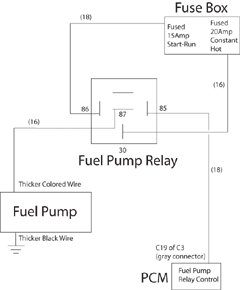 |
|
Fuel Pump Relay:
Note that the fuel sender is also part of the fuel pump module but was left off of this diagram. This will be discussed later. |
At this point, the engine should run, but there are still details to be dealt with to complete your swap. Those Details are as follows:
Wiring Gauges:
Here I will only cover wiring donor gauges. If you choose to use aftermarket gauges, instructions will be provided from the manufacturer. I won’t even begin to speculate on what gauges you might already be using.
|
Check Engine
Light: Because I did not install a check engine light on my swap, I did not want to put into my own words the specifics of this step. Instead, The following is information I found while browsing this online forum: CJ offroad "check engine light" discussion Info as follows: |
| ScottDeLano Posted - Aug 05 2003 : 10:12:12 PM “Scott, On the 2002, I understand that the entire instrument panel is a digital pulsed set up, so the entire cluster is run with only "ONE" wire. Evidently, the driver for it, is on the back of the panel. Looking at my 2002 Chrys. man. it's an LED, driven by a driver and won't tell you what makes up the driver. Soooo, in researching it, I found I needed a 270 or so, OHM resistor to bring the voltage from 12v to about 3.5v for the LED and a 2N2222 transistor for the light switch. Run a wire from a 'RUN-START' source to the short lead of the LED, a wire from the long lead of the LED to the resistor, then to the collector lead of the transistor. A wire from the emitter on the transistor to ground, and the center of the transistor (base) to the PCM MIL wire. Mine's, violet/yellow, might help, mine LED won't go out because of an evap. sol. sig and a fuel tank send unit sig. Hope this helps, Terry “ This is an email from SCOUT on Pirate regarding the MIL lite. FYI. [In reference to the “MIL LIGHT”:] ScottDeLano Posted - Aug 06 2003 : 1:13:13 PM I think he is refering to the "PCI Bus" also found in the Data link connector. On mine it is found in the #2 cavity of the DLK. I can't get to the 98 FSM right now. |
| Emissions Control
Systems: The following are reproduced diagrams from the FSM. I do not attempt to explain these systems in detail. |
|
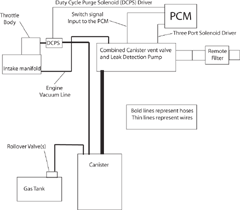 |
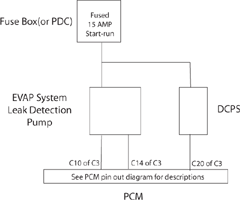 |
Troubleshooting
(*) See my warning on relays
Engine will run for 2 seconds or less and shut down.
Cause: PCM has a security device (sentry-key)
Solution- New PCM. The fuel delivery systems on TJ 4.0L 97-99 PCM’s are the same as the fuel delivery systems on 96-98 Grand Cherokees, meaning a TJ computer can run a Grand Cherokee engine or visa versa. If using the whole power train from a Grand Cherokee, only a Grand Cherokee PCM will do because the transmission is controlled by the PCM. On a TJ, only the lockout (on autos) is controlled by the PCM.
Engine will crank but not fire.
Possible Causes- CPS not correctly installed, no spark, no fuel (fuel pump relay or fuel pressure)
Solution- adjust CPS. See title “CPS (Crankshaft Position Sensor)” to see how to do this.
Solution- Check to see that the fuel pump relay is kicking on* when the key is turned to the “on” Position. If not, check wiring diagrams. If so, check to see that fuel pump is operating when relay is clicked on.
Solution- see below for no spark.
No Spark
Possible causes: ASD relay not hooked up properly or computer has no power, CPS not installed correctly, coil not hooked up, bad rotor or cap, bad plug wires, bad plugs.
Solutions: Check for spark at the coil first. If spark, then the problem is between there and the plugs (distributor, plugs, wires). If no spark, most likely problem is that the CPS is not right, or the ASD relay is not giving power* to the coil. Check diagrams to see that the computer is receiving power. Then check diagrams to see that ASD relay is hooked up correctly. Also check that all ground wires are connected to good grounds, including the computer ground. Check above to see how to adjust the CPS. * I encountered a problem with faulty relays. Certain brands would not have a contact on their actuator arms and would not give power to the circuit even when the control circuit was activated. If your having problems. Check your relay with an ohm meter to see that it is functioning properly
Follow @Off-Road

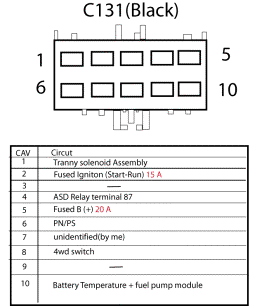

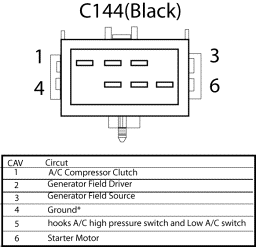

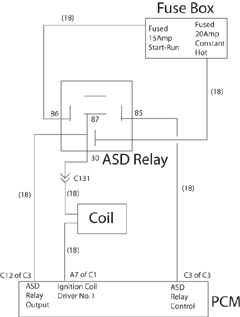
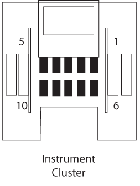




 Your Privacy Choices
Your Privacy Choices